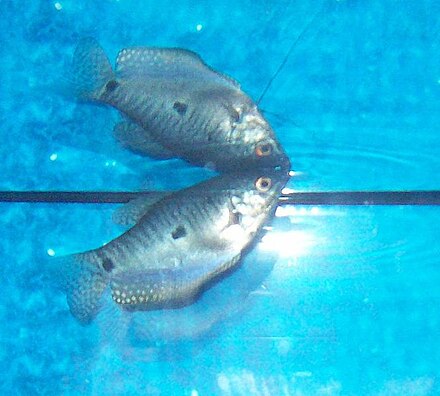Gourami
Gouramis, or gouramies /ɡʊˈrɑːmi/, are a group of freshwater anabantiform fish that comprise the family Osphronemidae. The fish are native to Asia—from the Indian Subcontinent to Southeast Asia and northeasterly towards Korea. The name "gourami", of Indonesian origin, is also used for fish of the families Helostomatidae and Anabantidae.
Many gouramis have an elongated, feeler-like ray at the front of each of their pelvic fins. All living species show parental care until fry are free swimming: some are mouthbrooders, like the Krabi mouth-brooding betta (Betta Simplex), and others, like the Siamese fighting fish (Betta splendens), build bubble nests. Currently, about 133 species are recognised, placed in four subfamilies and about 15 genera.
The name Polyacanthidae has also been used for this family. Some fish now classified as gouramis were previously placed in family Anabantidae. The subfamily Belontiinae was recently demoted from the family Belontiidae. As labyrinth fishes, gouramis have a lung-like labyrinth organ that allows them to gulp air and use atmospheric oxygen. This organ is a vital adaptation for fish that often inhabit warm, shallow, oxygen-poor water. Gouramis can live for 1-5 years.
Giant gouramis, Osphronemus goramy, or Kaloi in Malay language, are eaten in some parts of the world. In Maritime Southeast Asian countries, they are often deep-fried and served in sweet-sour sauce, chili sauce, and other spices. The paradise fish, Macropodus opercularis, and other members of that genus are the target of a cannery industry in China, the products of which are available in Asian supermarkets around the world. Gouramis are particularly found in Sundanese cuisine.[3]
In Malaysia, Indonesia, Thailand, Philippines, Brunei, gouramis are readily fished at streams, brooks, canal, rivers and many more large water area systems.
Numerous gourami species, such as the dwarf gourami, pearl gourami, are popular aquarium fish widely kept throughout the world. They are sought after due to their bright colours and relative intelligence, being able to recognise their owners and “greeting” them,[4] having a desire to explore the plants and rocks placed across their aquarium,[5] and displaying extensive paternal care with the males protecting the eggs until they hatch, and building a foam raft to keep them afloat.[5] As labyrinth fish, they will often swim near the top of the tank in order to breathe air.[6] As with other tropical freshwater fish, an aquarium heater is often used. Gouramis will eat either prepared or live foods. Some species can grow quite large and are unsuitable for the general hobbyist. Big Gouramis may become territorial with fish that are colourful and a considerable size to them, however that generally depends on the individual’s temperament as some gourami will be more tolerant of tankmates than others.[7][8] Gouramis may nip at other fish, and males should never be kept together as they will become aggressive.[6]
